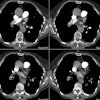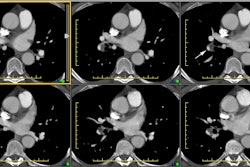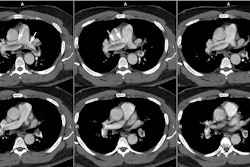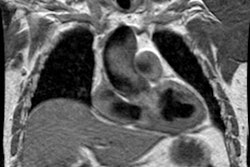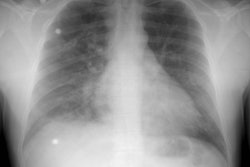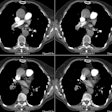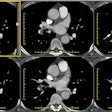Radiology 1997 Jun;203(3):727-732. Thoracoabdominal aorta in Marfan syndrome: MR imaging findings of progression of vasculopathy after surgical repair.
Kawamoto S, Bluemke DA, Traill TA, Zerhouni EA
PURPOSE: To determine the natural history of vasculopathy of the thoracoabdominal aorta in patients with Marfan syndrome after composite graft repair of the aortic root. MATERIALS AND METHODS: A total 224 magnetic resonance (MR) images obtained in 48 patients with Marfan syndrome over a period of 2.3-9.4 years (mean, 5.0 years) were retrospectively reviewed. On each image, the diameter of the thoracoabdominal aorta was measured and the presence of dissection or major peripheral artery aneurysms was determined. RESULTS: In 31 (65%) of the 48 patients, no statistically significant change (3 mm or less increase in diameter) in the diameter of the aorta occurred during the study (group 1); in the remaining 17 (35%) patients, a significant change occurred (greater than 3 mm increase) (group 2). The mean initial diameter of the native aorta was slightly larger in group 2 (mean, 27 mm +/- 8 [standard deviation]) than in group 1 (mean, 23 mm +/- 6). In group 1, the mean rate of dilation was 0.07 mm/y +/- 0.2; in group 2, the rate was 2.3 mm/y +/- 3.3. Two patients with aortic dissection were in group 1, whereas 14 such patients were in group 2 (P < .001). Aneurysms that involved major peripheral arteries were present in four (13%) of the 31 group 1 patients and in 12 (71%) of the 17 group 2 patients (P < .001). Surgical intervention was necessary in two group 1 patients and in 14 group 2 patients (P < .001). CONCLUSION: A subset of patients with Marfan syndrome manifested multiple forms of vasculopathy, including progressive aortic dilation, dissection, and peripheral artery aneurysm after composite aortic graft repair of the ascending aorta. Patients with these characteristics merit more frequent MR follow-up since further surgery was often necessary in these individuals.
PMID: 9169695, MUID: 97313091
